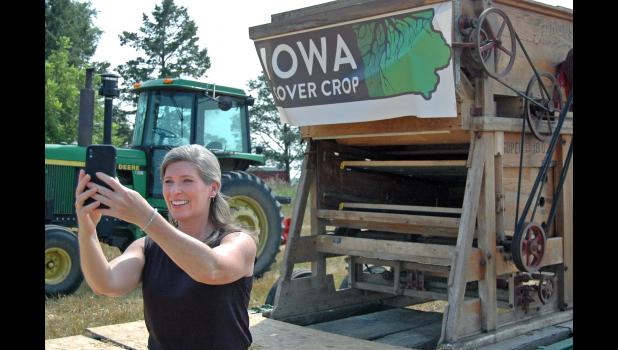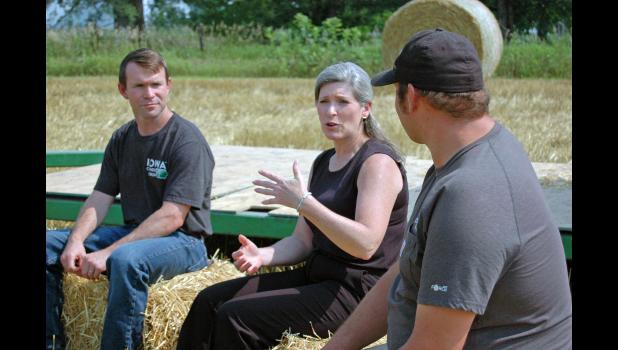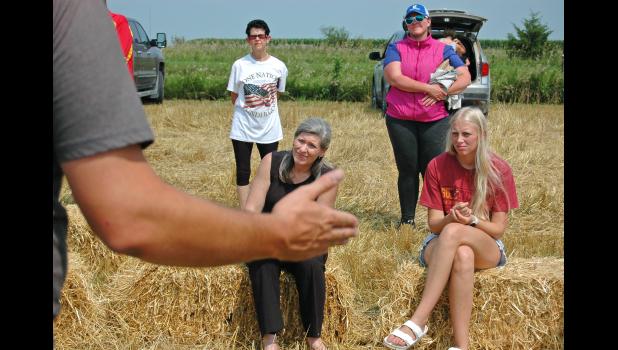'It's on us'
By ANDREW MCGINN a.mcginn@beeherald.com
Here’s a sobering thought: According to a new analysis of the Iowa Nutrient Reduction Strategy by the Iowa Environmental Council, most of us will never live to see the day when the state’s voluntary approach to reduce farm runoff by 45 percent meets its goal of having 12.6 million acres of cover crops.
At the current pace of adoption, the analysis found, it’s going to take 85 years to reach goal.
And it gets better. Er, worse.
The strategy — introduced in 2013 with a target date of 2035 to cut the amount of pollution that slides annually off fields into the Mississippi River watershed — also calls for 6 million acres of bioreactors and saturated buffers that would function as natural strainers for surface water trickling toward streams.
But at the current pace, it’s going to take 22,325 years to reach goal. (Who, or what, will be inhabiting this land 22,325 years from now is anyone’s guess.)
Local farmers James Holz and Bill Frederick don’t necessarily see despair — they see opportunity.
Tremendous opportunity.
As the founders of Iowa Cover Crop, the Greene County millennials have gone from selling 1,000 acres of cover crops in 2014 to nearly 200,000 in 2020.
“It’s a tiny, tiny amount,” Holz conceded Friday, “for how much opportunity there is in Iowa.”
Holz on Friday was addressing U.S. Sen. Joni Ernst, R-Iowa, who, as part of her 99-county tour, found herself taking a seat on a bale of straw in a wheat field south of Jefferson for a talk about cover crops with Holz and Frederick, their families and like-minded farmers that also veered into the lofty topic of carbon sequestration.
“Tell me one negative about cover crops,” Frederick said. “There are no negatives to cover crops.”
Cover crops are widely credited with holding nutrients in place following harvest when fields would otherwise be bare black.
Having rye, oats or turnips sprouting in the off-season reduces erosion and prevents excess nutrients like nitrogen and phosphorous from leaching into surface water that washes off fields, contaminating drinking water downstream and contributing to a hypoxic “dead zone” incapable of supporting marine life in the Gulf of Mexico.
Farmers don’t even have to necessarily be good at growing oats or turnips — cover crop seed is usually dispersed into standing corn or soybeans prior to harvest and terminated at planting.
“Rye will grow anywhere,” Holz said.
On the other hand, local farmers like Joel Lange, of Jefferson, who has rye growing amid soybeans, is anticipating a double-crop to increase revenue.
Yet, for all of the benefits, adoption of cover crops has been slow.
Of 30.5 million acres of total farmland in Iowa, the Iowa Nutrient Reduction Strategy has aimed to get cover crops on 12.6 million acres by 2035. But as of 2018, according to the Iowa Environmental Council, just 973,000 acres have cover crops on them — meaning 11.6 million more acres will be needed in the next 14 years to meet goal.
“Cover crops have a social benefit for the whole population of the state,” Holz explained.
“And making money while doing it,” Frederick added.
Rippey-area farmer and county supervisor Peter Bardole said the use of cover crops in his family’s operation has ultimately resulted in better yields because the soil retains nutrients.
Sarah Carlson, strategic initiatives director for Practical Farmers of Iowa, spoke up Friday during the discussion and noted it’s not like Iowa farmers are being asked to grow mangoes.
After all, before the corn-soybean rotation took hold, small grains were once a regular part of farming in Iowa. Rippey-area farmer Tim Bardole, a member of the Iowa Soybean Association board of directors, said it’s possible to pinpoint exactly when nutrient loads in the Raccoon River started increasing: when small grains left rotation.
“The land hasn’t changed,” Holz said.
A national report this past spring by the river advocacy group American Rivers listed the Raccoon River among the country’s top 10 most endangered rivers.
American Rivers, too, also took aim at Iowa’s volunteer strategy to reduce runoff pollution, saying it has “failed spectacularly.”
Of course, Iowa has another problem besides just perennial soil erosion. It’s possible that farm fields have never before been this awash with nutrients, thanks in large part to hog manure. Because of concentrated animal feeding operations (CAFOs) that generate massive quantities of waste, fields are being given more nutrient-rich manure and other fertilizer than crops can take up, the Iowa Environmental Council stated.
The excess leaves fields via surface runoff or drainage tile lines, leading to harmful algae blooms in the state’s own lakes and rivers that can cause severe illness in people and pets, and limit recreational opportunities.
In the years since implementation of the Iowa Nutrient Reduction Strategy — the only approach to mitigation favored by such powerful ag-interest groups as Farm Bureau — the Iowa Environmental Council says nitrogen leaving the state via waterways has actually increased.
“Typically with policy that is designed to protect the public,” the council stated in its analysis, “industry is not allowed to self-regulate.”
For her part, Ernst asked what she could do from the nation’s capital to boost cover crops and other conservation practices designed to reduce pollution.
Make cost-share reimbursement more streamlined, they said. But a lot of people don’t know cost-share assistance is available for cover crops either.
In its analysis, the Iowa Environmental Council touched on that, stating that even with 90 percent cost-share available for conservation practices, the majority of farmers in the Raccoon River watershed declined to participate, leaving 80 percent of available funds unspent.
“Our only competition is the people not doing it,” Frederick said.
That said, Iowa Cover Crop is flourishing. What started out as a way for two classmates from the Jefferson-Scranton High School Class of 2004 to diversify their farm income has become a full-time endeavor, with their wives leaving their jobs and joining the operation as well.
“We started out as weirdos,” Frederick said. “Now it’s more mainstream.”
A growing dealer network they established for seed in Iowa and Nebraska — “We like to say we sell everything except corn and soybeans,” Holz says — is made up of farmers their age.
They’ve found that the only obstacle to getting more farmers to plant cover crops is, well, farmers. More specifically, many farmers are hesitant to do something their neighbor isn’t.
Call it agricultural peer pressure.
No one wants to have the field that looks different, Holz said.
It’s the reason why fields with cover crops on them are found in pockets, according to Frederick.
“I know a guy who quit (using cover crops),” Peter Bardole said, “because he thought his corn looked too short.”
Even so, cover crops are a proven way to improve water quality — and may hold even greater potential in the coming years.
Talk is now of the coming dawn of “carbon farming” as a way to fight climate change, with Gov. Kim Reynolds on June 22 signing an executive order creating a task force that will explore carbon sequestration.
Here’s roughly how it could work: a farmer in Greene County, or anywhere else in the Midwest, would adopt a raft of conservation practices with the goal of capturing so much carbon dioxide in the soil and vegetation. That farmer could then sell carbon units or credits to a buyer in the industrial sector who needs to offset their emissions of greenhouse gases.
Talk on Friday centered around the need for a market to exchange carbon units between farmers and manufacturers.
However, Al Frederick, Bill’s dad, perhaps summed up the current skepticism best, saying, “I’m selling carbon so they can keep doing wrong. I don’t get it.”
The reality is, Ernst explained Friday, some industries may never achieve a carbon-neutral stance.
“We’re entering brand new territory,” she said.
That climate change is even occurring is no longer the question, according to the 2020 Farm Poll conducted by Iowa State University Extension and Outreach, which found that 81 percent of farmers believe climate change is occurring — up from 68 percent in the 2011 poll.
The 2020 poll also showed a 43 percent increase in the use of no-till farming and a 22 percent increase in the use of cover crops — but, on the down side, there was a 32 percent increase in pesticides, perhaps due to a climate that becomes a little more inhospitable each season.
Speaking about Congress, Ernst said that climate change has become a part of the conversation in D.C., but usually to the detriment of ag producers.
“Oftentimes,” she said, “they think farmers are the problem. We have a lot of education in that area.”
The way Bill Frederick sees it, education begins right at home with everyday farming practices.
“If we want to clean up our image,” Frederick said, “it’s on us.”
Learn more about carbon markets
Iowa State University Extension and Outreach will hold a free public webinar from 1 to 3 p.m. Aug. 11 to discuss renewed interest in carbon markets and carbon credit trading.
Specialists will discuss the basics of what a carbon market is; how people can participate; the benefits and consequences of participating; and the things landowners and tenants should consider.
“Some farmers are already being asked to join marketing agreements,” said Chad Hart, professor in economics and extension grain markets specialist at Iowa State University. “Over the last six to eight months in particular, we have seen a lot of private companies starting to set up their carbon trading mechanisms and some are reaching out to landowners.”
Hart will discuss the economic aspects of a carbon market and the potential for additional income.
According to ISU, a clear connection exists between certain farming practices — especially conservation practices — and measurable carbon sequestration.
The webinar will be provided via Zoom. To participate, visit: https://iastate.zoom.us/j/99971383632#success
There is no pre-registration.
- Log in to post comments




